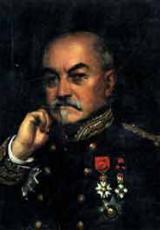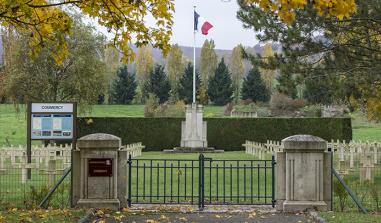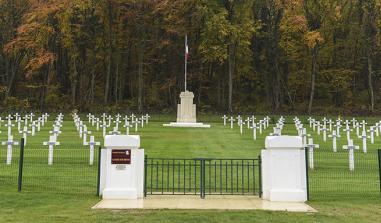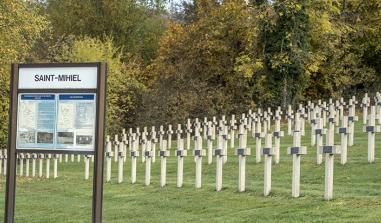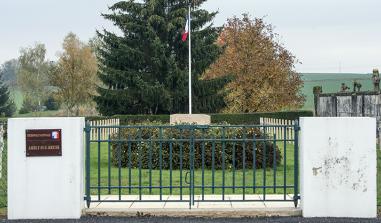Fort Souville
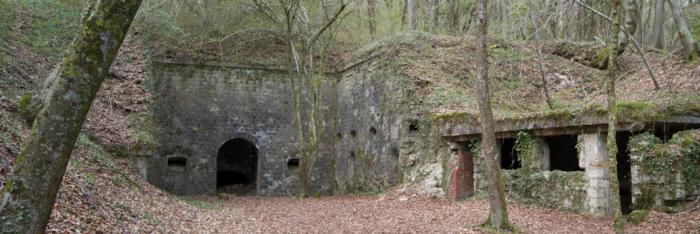
Le fort de Souville. Source : http://ecolenotredameduguildo.blogspot.fr/
Captain Gustave de la Taille, who built this fort, named it Souville, a Loiret village.
Last Judgement at Verdun
After their major attacks on 21 February, 10 April and 25 May 1916, the Germans occupied the elevated côte du Poivre and the côte des Chambrettes on the right bank of the Meuse, as well as Fort Douaumont, a particularly important vantage point which was to become an essential part of the enemy's logistical plan. On 7 June, the enemy got as far as the defending ranks on the Fort Vaux, and those on the front lines reached the Eastern slopes of the high ridge punctuated by Thiaumont, the ruins of Fleury village and the Fort Souville. If the Germans managed ito take this ridge, their artillery would be able to fire straight at Verdun and the bridges over the Meuse from less than 5000m away, thus putting the French in grave danger. If, on the other hand, the ridge remained French, then not only would it be possible to defend the right bank, as Commander in Chief Joffre ordered, but it might also be possible to counter-attack and take back the forts at Vaux and Douaumont.
While the obdurate enemy charged to take the Thiaumont-Fleury-Souville ridge, the period from June to September constituted "the last judgement at Verdun," a horrible drama in which the epic, partially destroyed (1) Fort of Souville saved the day no fewer than three times. On 23 June, when the violent German offensive began, Souville dominated and flanked the entire combat zone. The French artillery used it as a look-out post from which to barrage the blocked enemy infantry with projectiles. On 11 July at dawn, the Germans charged at Souville. They did the same on the 12th, and got as far as the fort. Thanks to the artillery and the counter-attacks of the 7th Regiment and the 25th Batallion of Light Infantrymen, the few enemy soldiers that actually reached the fort were imprisoned. Souville escaped German clutches. The parallel ridges of Froideterre and Souville - Thiaumont and Froideterre on the one hand, the Forts of Vaux and Souville on the other - all played a major role in directing the enemy attack. Once Thiaumont was taken, the enemy effort ground to a halt on Froideterre. Fort Vaux fell to the Germans on 7 June, but on 11 and 12 July, Souville came to the rescue once again. Once Fleury was taken, the Germans rushed to take advantage of the ravines at la Poudrière, but because Froideterre and Souville were still in the hands of the French, it was impossible for them to capitalize on their success: they were threatened on all sides. This month-long battle for Souville-Fleury-Thiaumont revealed the vital role of permanent fortifications in the Battle of Verdun. And it was thanks to the combination of the extraordinary resilience of Verdun's "poilu" soldiers and the energy of the high command that this battle was won and Verdun saved. (1) From 21 June on, it was subject to daily attacks that gravely crippled its defences.
Souville's fortified massif A complete defence system
Captain Gustave de la Taille, the ingenious officer who built this fort, gave it the name of the Loiret village -- Souville -- in which his ancestor, Bertrand de la Taille, groom to the Lord of Souville, had been laid to rest in 1319. In 1916, this massif consisted of: Fort Souville: situated at 388m above sea level (at precisely the same altitude as the Fort Douaumont), and built between 1875 and 1879 from limestone covered with 3-5m of earth. The ditches that surrounded it featured built-in scarps and counterscarps, flanked by caponniers armed with revolver cannons and 12 tonne breechblock canons. In 1889, the whole thing was wrapped in barbed wire 30m thick. It was one of the Séré des Rivières belt's "first generation" forts, like those at Belleville, Saint Michel and Tavannes. In 1888, the gunpowder magazine was reinforced with 2.5m of concrete and a 1m thick layer of sand. Connecting passageways were built, as well as six 18m by 5m shelters, each protected by an 8m thick layer of blocks made from rock, marl, and loose stones. The fort housed the district's telephone exchange, consisting of two underground lead circuits that connected it to Fort Douaumont and the fortification at Thiaumont, plus two overhead cables linking other forts and the Verdun citadel exchange. Before conflict began, there were plans to establish a communication system for clear days, using lights, with the fortified town of Longwy, more than 35km away as the crow flies
An organic garrison: 2 infantry troops, 2 artillery sections, reinforcement gun crews for sixteen machine guns and various service personnel indispensable to the life of the fort. In peacetime, the fort was accessed via a gravel path -- named "le chemin de Souville," it is still in use today. It leads to the drawbridge of the wartime entrance, an underground shelter with room for 300 seated men. Serpentine back alleys lead from this introductory path, winding out of the path of gunfire. A Bussière system eclipse gun turret for two 155 mm canons, built in 1890-1891 150 metres west of the fort. Around 600 shells were fired from this turret between 24 February and 6 March 1916, but when one of its two tubes exploded on 10 April of the same year, it was decommissioned. It was March 1917 before it was back in action, now just a single tube powered by a twelve horsepower electric motor instead of the original steam one. From this time on, the turret was linked to the fort and the emergency exit via a 140m long bombproof alley. A De Bange 155 terraced fortress battery built in 1882, with built-in recessed niches for weaponry half a metre thick. The niches faced West, and were situated about 100m from the Bussière turret. Some remains of the battery can still be seen today and are indicated on the massif's discovery trail, which begins at the memorial.
Criss-crossing alleys form a communication network that can still be seen all over the fortification -- it ensures that relief soldiers can arrive, the injured can be taken to safety, food supplies, arms and equipment can arrive. The network begins both at the Marceau barracks (one of the entrances to the battlefield) towards Souville and at the village of Fleury, then heads for the river and the village of Vaux (the Carrières alley), the Vaux Régnier, Fumin woods and Fort Vaux. It means that even without underground passageways, there are internal connections at the heart of the massif between the fort, the 155mm gun turret and the fortress battery. In May and June 1916, it comes under attack from 380 mm (750 kg) and 420 mm (1 000 kg) shells, which destroy all the stone spaces, the caponniers, the barbed wire fence, the five 90mm carriage cannons and two 15mm mortars. Afterwards, the defenders and lookouts have to occupy the holes made by the shells, and are totally unprotected. After the Battle of Verdun is over, major work begins to restore the fortified massif at Souville: wells yielding 1 500 litres a day, underground shelters linked by tunnels, lined with 10 to 15 metres of protective compacted marl, a 140m tunnel linking the fort to the renovated 155mm gun turret, with a 12 horsepower electric motor replacing the previous slow and complicated steam system, an emergency exit for the 155mm gun turret with a Digoin concrete observation post. It is surrounded by a barbed wire fence between 20 and 30 m thick. In 1917, three Pamart casemates weighing 2.5 tonnes with 14cm shields are installed on the fort's slopes for its imminent defence. These fixed gun turrets cannot be withdrawn, and each one features two carriage-mounted machine guns. Because of their design, they have a 160 degree range, less than that of the 1900 model machine gun turret (360 degrees). However, their more modest dimensions and weight mean that they are easier to build and to install during a campaign on the particularly troubled terrain of Verdun. They are also more reliable than the eclipse gun turret, which often gets blocked by rubble when shells explode.
1917: Making the forts stronger
Developed during the war by Commander Pamart serving at Fort Génicourt, these machine gun casemates were also built and installed in the heat of the battle, from 1917 on, to enhance the firepower of several forts and ensure their defence. In 1917, three of these casemates were installed at Fort Souville for the imminent defence of the glacis. They weighed 2.5 tonnes apiece, providing a 14cm shield. Each of them featured two carriage-mounted machine guns with a small arm range of 160 degrees, less than that of the 1900 model machine gun turrets, two of which can be seen on the Froideterre fortification. The Pamart casemate could not be withdrawn; however, their more modest dimensions and weight meant that they were easier to build and to install during a campaign on the troubled terrain of Verdun. They were also more reliable than the eclipse gun turret, which often got blocked by rubble when shells exploded. The Pamart casemate had two small openings at or close to floor level which could be filled with metallic plugs. Inside, two superimposed Hotchkiss machine guns alternated firing. One fired through one of the two openings while the other waited below. Simply by rotating the guns, the sniper could charge one gun while firing the other. The machine gun cannon being fired projected 30cm out from the opening. A ventilator assured that the air was breathable inside the casemate, pushing combustion gases outside. Some casemates had two blockable holes in the roof for a periscope.
Practical Information:
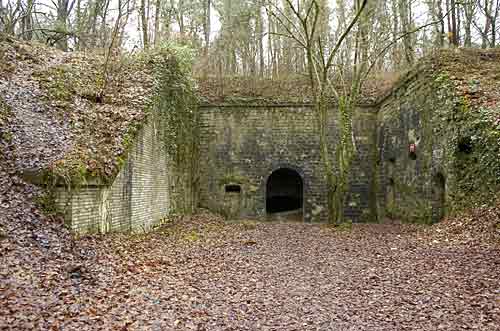
Souville Fort. Photo by JP le Padellec
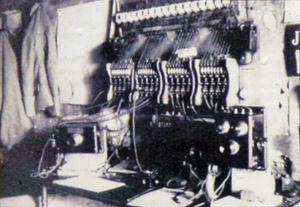
Telephone exchange. Source: Conseil Général de la Meuse
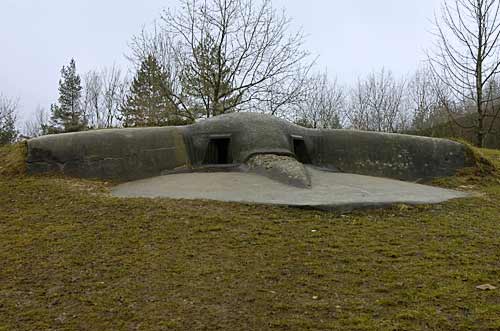
Pamart casemate. Photo JP le Padellec
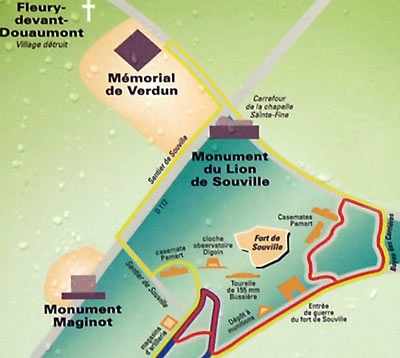
Souville - finding your way
Practical information
55100
Fleury-devant-Douaumont
Accessible toute l'année



